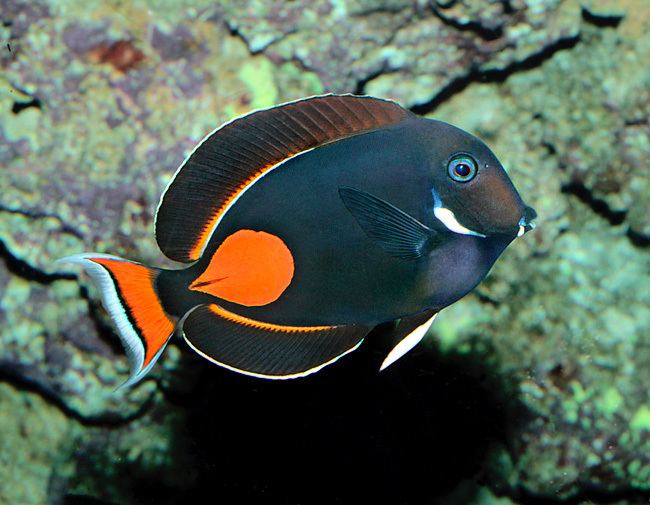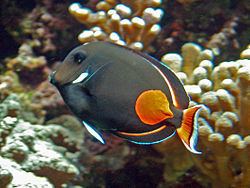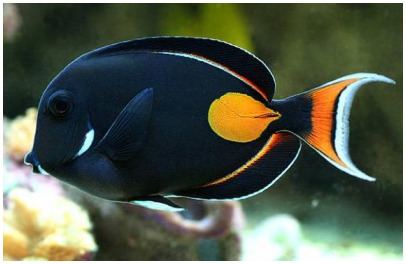Order Perciformes Higher classification Acanthurus | Phylum Chordata Scientific name Acanthurus achilles Rank Species | |
 | ||
Similar Acanthuridae, Acanthurus, Acanthurus leucosternon, Sohal surgeonfish, Acanthurus lineatus | ||
Achilles tang care acanthurus achilles
Acanthurus achilles, commonly known as Achilles tang or Achilles surgeonfish, is a tropical marine fish native to the Pacific Ocean.
Contents
- Achilles tang care acanthurus achilles
- Achilles tang acanthurus achilles liveaquaria
- Description
- Diet
- Distribution and habitat
- In the aquarium
- References

Achilles tang acanthurus achilles liveaquaria
Description

They are a medium surgeonfish reaching a maximum of 25 cm (10 in) at adulthood. Acanthurus achilles are black with striking orange and white lining along the fish's fins and tail. When the fish matures, a prominent orange drop shape develops on the caudal area, terminating into a sharp spine.
Diet

The Achilles tang is herbivorous, eating mostly benthic algae. They will also accept frozen and meaty foods such as brine shrimp and mysis shrimp in captivity. As with all surgeonfish, algae or similar vegetable matter should be included in their dietary intake to moderate aggression and regulate metabolic functions.
Distribution and habitat

It is found in various reefs of Oceania, up to the islands of Hawaii and Pitcairn. The fish is also, although less commonly, found in the Mariana Islands and even some reefs in southern Mexico and Guatemala.
In the aquarium
The Achilles tang has a poor survival rate when kept in captivity. They are not for the inexperienced aquarist. However, a more experienced saltwater aquarist might think about keeping an Achilles. They are peaceful aquarium inhabitants and will rarely bother their tank-mates. Just about the only exception is when kept with other tangs or surgeonfish, particularly of their own species. Then they will become aggressive towards the other Tang. They are reef-safe, and can be kept with any invertebrates. Possible tankmates include clownfish, blennies, gobies, Chromis, butterflyfish, and small lionfish.
Turbulent water flow and surface movement (either in the display aquarium or attached sump) is essential for Achilles health. Heavy surface movement brings water oxygen levels near saturation. Keeping an adult Achilles well fed can be a chore, with one adult easily consuming one 5"×5" sheet of pressed seaweed daily. Selcon-type products can be utilized several times a week to supplement their diet. A lowered reef temperature of 78 °F can also assist in keeping an Achilles fat. A standard reef temperature of 80–82 °F will raise the Achilles' metabolism to a point where adequate nutrition will be difficult. Introducing a specimen of about 5 inches is ideal; juveniles do not fare well (if they can even be found).
